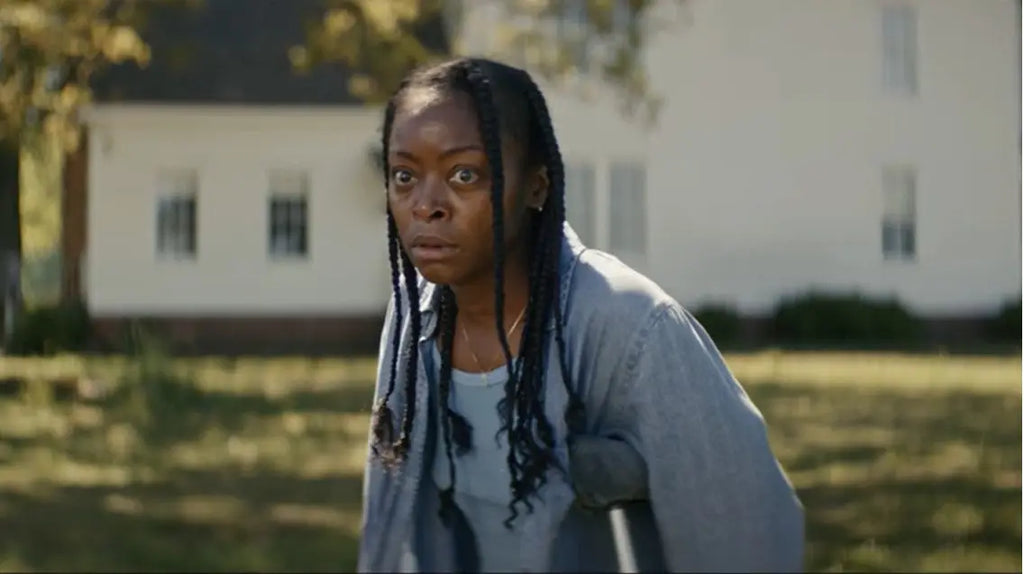Grief is a horror all its own. Many great horror films have explored the ways that loss and pain manifest into something more tangible, something inescapable, something that stares back at you from the darkness. The Woman in the Yard, the latest from Blumhouse and director Jaume Collet-Serra, takes this idea and gives it a literal, haunting presence. It’s an effectively chilling premise: a strange, mysterious woman, clad entirely in black, suddenly appears on a grieving mother’s lawn and refuses to leave. She does not move - not at first - but she does speak. And what she says is unnerving: today’s the day.
Danielle Deadwyler takes the lead as Ramona, a woman whose life has unraveled following the sudden death of her husband (Russell Hornsby). The accident that took his life left her seriously injured, forcing her to rely on crutches to get around, a visual and physical representation of her helplessness. She is now solely responsible for their two children - teenage son Taylor (Peyton Jackson) and six-year-old daughter Annie (Estella Kahiha) - as well as their struggling rural farm. The bills are piling up, the work is overwhelming, and the emotional weight of it all has left her practically immobilized. She barely gets out of bed, leaving Taylor to shoulder much of the responsibility. Their relationship is fraught; he’s frustrated, she’s withdrawn, and Annie is caught between them. Then the woman in the yard appears.
The film’s early moments play up the unnerving simplicity of its premise. The woman, played with eerie stillness by Okwui Okpokwasili (Agatha All Along), is just there - watching, waiting. Ramona assumes she’s lost, maybe mentally ill, but something about her presence feels unnatural. The film’s camerawork, provided by Pawel Pogorzelski (Hereditary, Midsommar) enhances this, using tight, creeping shots to evoke a sense of tunnel vision and unease. Sound design plays a major role, too - the buzzing of insects, the crunch of dry grass, the sharp clack of Ramona’s crutches against wood and dirt - all of it keeps the tension simmering.

When the woman finally speaks, her voice is chillingly disembodied. She doesn’t need to shout, yet her words cut through the thick summer air as though whispered directly into Ramona’s ear. And she knows things. She pries into Ramona’s life with quiet, unrelenting certainty. The effect is terrifying. As night falls, the situation only worsens. The family is already struggling - their power has been shut off due to unpaid bills, their phones are dead, and their isolation is palpable. The woman, however, is undeterred. She creeps closer, her presence becoming more invasive, her intentions more ominous.
At its best, The Woman in the Yard revels in its slow, creeping dread. The first hour is genuinely unsettling, filled with striking imagery and expertly crafted suspense. Collet-Serra, who cut his teeth in the horror genre with works like House of Wax and Orphan, returns to his horror roots after years in the blockbuster trenches and brings a keen sense of visual style, turning simple shadows and stillness into sources of terror. But as the film progresses, cracks begin to show. The mysterious horror of the woman starts to shift into something more tangible, and in doing so, the film loses some of its power. Once her abilities are fully revealed - shadowy tendrils, unnatural distortions, supernatural manipulations - the film begins to feel less like a psychological horror and more like a standard haunted house flick. The pacing drags, the tension starts to wane, and the film struggles to sustain its runtime.
This is the central issue with The Woman in the Yard - its premise is strong, but it feels stretched too thin for a full-length feature. Once the themes and metaphors become clear, the film doesn’t offer much new insight into them. The depiction of grief and trauma is effective, but familiar; we’ve seen these themes tackled in other horror films, often with more depth. The climax, though visually arresting, feels like a predictable culmination rather than a revelatory moment. And by the time the credits roll, the film has taken so long to reach its resolution that its impact is dulled.

That being said, the performances elevate the material. Deadwyler (Till, The Piano Lesson) is a powerhouse, bringing layers of pain, exhaustion, and desperation to Ramona. She’s mesmerizing to watch, carrying even the weaker moments of the film with sheer presence alone. Jackson and Kahiha also do well, selling the fractured family dynamic at the heart of the story. And Okpokwasili’s eerie, almost otherworldly performance as the titular woman is chilling in its simplicity.
Ultimately, The Woman in the Yard is a stylish, well-acted horror film with a killer concept that falters under its own weight. It’s unsettling, yes, and filled with memorable imagery, but it never quite becomes the knockout it sets itself up to be. The early tension and psychological horror are its strongest assets, but as the supernatural elements take center stage, the film loses some of its uniqueness. Fans of slow-burn horror will find plenty to admire here, but those looking for something truly fresh may come away feeling that, much like the woman herself, this one lingers a little too long.
'The Woman in the Yard' is now playing in theaters.



